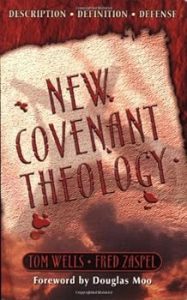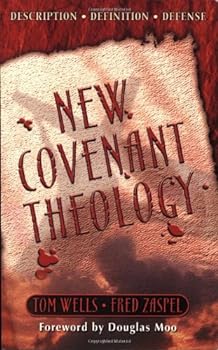Wells, Tom, and Fred G. Zaspel. New Covenant Theology: Description, Definition, Defense. Frederick, MD: New Covenant Media, 2002, $79.99. Paperback.
How one puts together the Old and New Testaments is a massive conversation. Does one emphasize continuity or discontinuity between the testaments? How does one understand the relation between Israel and the church? What do those in the New Covenant do with the Old Covenant law? And on and on one could go asking relevant questions on this topic. Any endeavor to bring clarity to these questions and this conversation is both a daunting and a needed task, which is why I am thankful for the time-honored classic New Covenant Theology: Description, Definition, Defense by Tom Wells and Fred Zaspel. Though written over twenty years ago, this work brings clarity and conviction to this conversation from a New Covenant Theology (NCT) perspective that is still relevant today.
Tom Wells is a writer and preacher who lives in West Chester, Ohio. He pastored The King’s Chapel (Reformed Baptist Church) in West Chester for nearly thirty years. He has published several books including Come to Me!, Christian: Take Heart!, A Price for a People, The Moral Basis of Faith, and A Vision for Missions. Fred Zaspel serves as a pastor at Reformed Baptist Church in Franconia, Pennsylvania, adjunct professor of systematic theology at the Southern Baptist Theological Seminary in Louisville, Kentucky, executive editor of Books at a Glance, and a project editor at The Gospel Coalition. He has written several books including The Theology of B.B. Warfield: A Systematic Summary, Warfield on the Christian Life: Living in Light of the Gospel, and The New Covenant and New Covenant Theology.
The authors begin the book with a preface that sets the stage for all that follows. In their preface, they offer five justifications for their work and then they work through each justification in depth in the first chapter. Perhaps the most important justification which affects the foundation of NCT as a system is the need to read the OT in light of the NT. As they state on page 14, “We must certainly read the rest of Scripture in light of the apex of revelation, which is the NT. Read it all we must! But which testament controls our thinking and which we use for finetuning is the all-important consideration.” Continuing this line of thought, chapter one offers a defense of each of the five justifications from the preface. In this chapter, Wells relates the goal of NCT by stating, “It is to join together three things: the logical priority of the NT over the Old, the logical priority of Lord Jesus over his godly predecessors, and the logical priority of the theology of the text over our own theologies and those of others” (22). If one needed a summary of what NCT was all about, this would be it.
In the rest of the book, the authors offer a description of divine revelation and how it climaxes in the NT Scriptures (chapter 2), a thorough description of the New Covenant (chapters 3-4), a nearly exhaustive treatment of Matthew 5:17-20 and its implications on this conversation (chapters 5, 6, 7, 8), a discussion about the continued relevance of Divine law (chapter 9), a discussion about the meaning and source of moral law (chapter 10), a response to a critic of their view (chapters 11-12), a couple of test cases in which their view is related to the Sabbath (chapters 13-14), and, finally, a chapter on how Creeds affect one’s understanding on this topic (chapter 15).
Wells and Zaspel’s New Covenant Theology is a fascinating and thoughtful work that is sure to stimulate the minds of almost every reader. Their writing is clear, convictional, and enjoyable. For the purpose of this review, positive evaluations will be discussed first, and then critical evaluations will follow.
First, Wells and Zaspel give a great amount of attention to one of the most debated aspects in the covenantal/dispensational conversation, that is, the relation of the Christian to the Law of Moses. Arguably, this is the focus of the entire book. Though NCT theologians are often accused of being antinomians, Wells and Zaspel are quick to dismiss this claim and provide further clarity of their view. They write,
Jesus is to Moses what the butterfly is to the caterpillar. Moses is not struck down. Moses did not “fall” (Luke 16:17). Nor was he “destroyed” (Matt. 5:17). Moses is “fulfilled.” In Christ, Moses reaches maturity and emerges in full bloom. Moses’ law still has relevance, but only as it comes to us from the hands of the Lord Jesus. Christians today must still read Moses, and for great profit, but when they read him they must be careful to wear their Christian lenses. Moses’ law is not simply incorporated into the New Covenant as it was revealed through Moses–it is fulfilled, advanced, and brought to completion (157).
In other words, they do not denigrate the law; instead, they emphasize its fulfillment in Christ and clearly state that it is still relevant to the Christian today, but only through the interpretive lens of Christ. While some may not be convinced of their argument, accusations that Wells and Zaspel advance antinomianism is unfounded and based upon a misunderstanding of what they are saying.
Second, the irenic spirit throughout the book, especially when interacting with the views of others and critics, is to be commended. Wells and Zaspel seem to desire honest and informed conversation on this incredibly important topic. Though passions often rage when these matters are discussed, their book is a welcome example of thoughtful interaction and charitable dialogue.
Next, and shifting to the critical evaluation, one weakness is that there is not enough time spent on other texts/topics related to the covenantal/dispensational conversation. They spend a significant amount of time on Matthew 5:17-20 (4 chapters!) and the law but give a more cursory survey of other relevant texts and topics. For example, an extended discussion on Hebrew 8 or 2 Corinthians 3 would have been helpful in further delineating their views, as well as a more thorough discussion on NCT’s view of the church and Israel, baptism, the covenant of redemption/works/grace, etc. It is not that Wells and Zaspel ignored these matters altogether, it is rather that they were not sufficiently dealt with in detail. In other words, in order to advance the covenantal/dispensational conversation and perhaps persuade one to become a NCT theologian, more explanation of the fundamental points of divergence between the various systems is needed.
For those unfamiliar with NCT, this resource is a great place to begin learning more about its distinctives and viewpoints. Though several other books on NCT have been printed since this volume first came on the market, New Covenant Theology remains a classic representation and defense of NCT. Wells and Zaspel have penned a thoughtful and insightful work that will challenge the thinking of almost every reader. This reviewer recommends it.
W. Tyler Sykora
Midwestern Seminary





